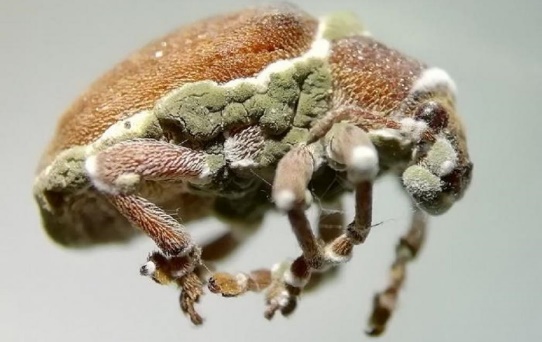





Disclaimer: Copyright infringement not intended.
Context
Identification and Characterization of Pathogenic Fungi:
Eucalyptus Snout Beetle: A Menace to Eucalypts:
Challenges and Current Control Methods:
Impact and Spread of the Beetle:
Entomopathogenic Fungi and Bio-Pesticide Development:
Global Implications and Bio-Pesticide Application:
Evaluation of Biological Insecticides:
Eucalyptus Forests Worldwide and Economic Impact:
Fungi Development and Adaptation for Bio-Pesticide Production:
|
PRACTICE QUESTION Q. Consider the following statements regarding the Eucalyptus snout beetle and recent scientific developments: 1.Eucalyptus snout beetle (Gonipterus platensis) is a leaf-feeding beetle indigenous to Australia, known for causing defoliation in eucalyptus plantations. 2.Scientists have successfully implemented a novel technique to genetically modify Eucalyptus trees, enhancing their resistance to the Eucalyptus snout beetle. 3.Microwasps of the genus Anaphes spp. are commonly used to control Eucalyptus snout beetle populations, but they are considered an expensive solution. Which of the statements above is/are correct? A) 1 only B) 2 only C) 1 and 3 only D) 2 and 3 only The correct answer is: C) 1 and 3 only Explanation:
This statement is correct. The information aligns with the details provided in the passage about the origin and impact of the Eucalyptus snout beetle.
This statement is incorrect. The passage does not mention any genetic modification of Eucalyptus trees as a method to control the Eucalyptus snout beetle. The focus is on the use of a naturally occurring pathogenic fungi to develop a bio-pesticide.
This statement is correct. The passage mentions that microwasps are used for controlling the Eucalyptus snout beetle but are considered expensive, leading scientists to explore alternative solutions. Therefore, the correct answer is C) 1 and 3 only PRACTICE QUESTION Q. Which of the following statements regarding Microwasps (Anaphes spp.) is correct? 1.Microwasps are genetically modified organisms engineered for pest control in agriculture. 2.Microwasps is commonly used to control the Eucalyptus snout beetle, a major defoliator of eucalyptus trees. 3.Microwasps belong to the order Diptera and are known for their parasitic behavior on insect larvae. Select the correct answer using the code given below: A) 1 only B) 2 only C) 2 and 3 only D) 1 and 2 only The correct answer is: B) 2 only Explanation:
This statement is incorrect. The passage does not provide information about microwasps being genetically modified organisms. It mentions microwasps (Anaphes spp.) as a method to control the Eucalyptus snout beetle but does not specify genetic modification.
This statement is correct. The passage indicates that microwasps of the genus Anaphes spp. are used for controlling the Eucalyptus snout beetle.
This statement is incorrect. The passage does not provide information about the taxonomic order of microwasps (Anaphes spp.). Therefore, this statement cannot be confirmed. Therefore, the correct answer is B) 2 only.Top of Form |





© 2026 iasgyan. All right reserved